Physical Address
304 North Cardinal St.
Dorchester Center, MA 02124
The gallbladder is a long oval-shaped organ that is positioned beneath the liver immediately adjacent to the interlobar fissure ( Fig. 2-1 ). The fissure can be a useful landmark for locating small contracted gallbladders or gallbladders that are completely filled with stones. Likewise, the gallbladder can be used as a landmark for identifying the junction between the left and right hemiliver. The upper limit of normal for the transverse dimension of the gallbladder is 4 cm. The length of the gallbladder is more variable but generally does not exceed 10 cm. The normal upper limit for the gallbladder wall thickness is 3 mm. When the gallbladder contracts, the echogenic mucosa and the hypoechoic muscularis become apparent and the wall may appear thickened ( Fig. 2-2 ). However, even with gallbladder contraction, the wall usually remains less than 3 mm thick. The characteristics of a normal gallbladder are presented in Table 2-1 .


| Characteristic | Appearance |
|---|---|
| Location | Inferior to interlobar fissure Between left and right hemiliver |
| Size | <4 cm transverse <10 cm longitudinal |
| Wall thickness | <3 mm |
| Lumen | Anechoic |
Variations in the shape of the gallbladder are common. There are frequently one or more junctional folds in the gallbladder neck and occasionally there are folds throughout the gallbladder ( Fig. 2-3 ). When the gallbladder fundus folds on itself, it is referred to as a Phrygian cap (see Fig. 2-3D ). Gallbladder folds may mimic septations but it should be possible to demonstrate a change in the outer contour of the gallbladder. Septations are rare and generally appear thinner than folds. They separate the gallbladder into segments that communicate, sometimes through a small pore ( Fig. 2-4 ) ( e-Fig. 2-1 ![]() ).
).
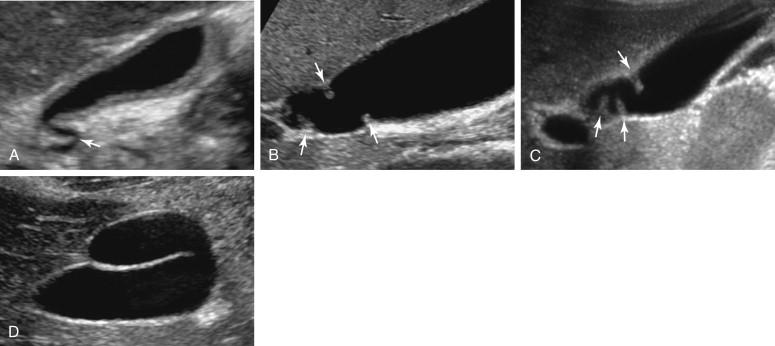
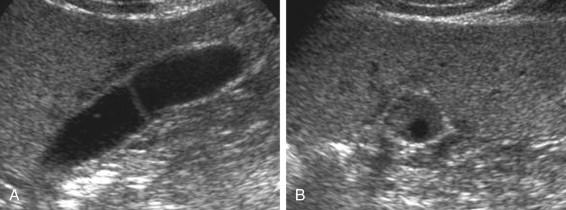

Congenital variations in the location of the gallbladder are rare; intrahepatic gallbladders are probably the most frequently recognized. Most intrahepatic gallbladders are located immediately above the interlobar fissure ( Fig. 2-5 ). Variations in the shape or size of the liver may cause variations in the configuration or location of the gallbladder ( Fig. 2-6 ). Gallbladder duplication is another rare congenital anomaly that may be complete ( Fig. 2-7A ) or partial (see Fig. 2-7B ). Agenesis of the gallbladder has also been reported.
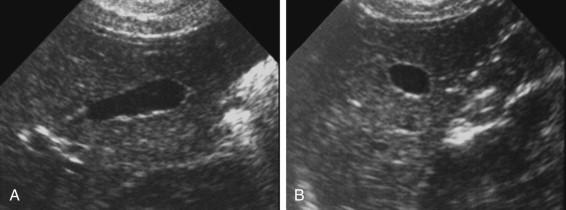
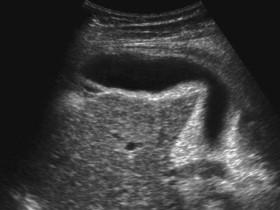
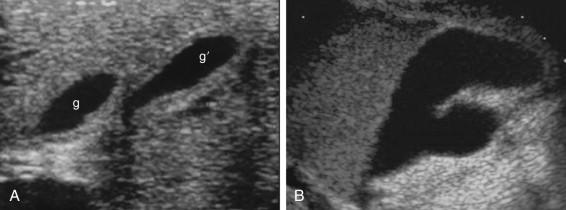
Ideally, patients should fast 8 hours after midnight before they undergo a gallbladder sonogram to ensure adequate gallbladder distention and to reduce upper abdominal bowel gas. A recent meal makes the examination harder to perform and interpret and also decreases diagnostic sensitivity. However, in most cases, diagnostic information can be obtained even in nonfasting patients, and therefore a recent meal is not an absolute contraindication to performing a gallbladder sonogram.
Most gallbladder examinations start with the patient in the supine position using a 3- to 5-MHz sector transducer. The gallbladder should be scanned from both subcostal and intercostal approaches whenever possible. Often one approach will display pathology and/or diminish artifacts better. When scanning from a subcostal view, a deep inspiration will usually allow better visualization. Artifactual low-level echoes resulting from reverberations are frequently present in the gallbladder lumen. They can often be eliminated by scanning from a more lateral and superior approach (often from an intercostal space) and using more of the liver as a window. Scans should routinely be obtained with the patient in a variety of positions (left posterior oblique, left lateral decubitus, prone, upright) to document mobility of intraluminal structures, such as stones and sludge, and nonmobility of polyps and tumors. The prone position is most useful in patients in whom the gallbladder is in a horizontal orientation with the fundus located anteriorly. In some patients, the gallbladder may be hard to see in the prone position. Nevertheless, stones that fall into the fundus when the patient is prone can be seen in real time falling back into the neck as the patient rolls from a prone to a supine position. The upright view is most useful in patients in whom the gallbladder is in a vertical orientation with the fundus located inferiorly. Upright views can be obtained in the sitting position, although it is usually easier to scan with the patient standing. Although it is important to visualize the entire gallbladder, the gallbladder neck is especially important, because stones can be missed if the entire neck is not visualized, if a stone is positioned behind a junctional fold, or if the stone is impacted in the neck ( Fig. 2-8 ). It is also important to ensure that abnormalities in the fundus are not obscured by bowel gas.

Gallstones are present in up to 10% of the population. In North America, gallstones are composed primarily of cholesterol (75%) and pigment (25%). The majority (60% to 80%) of gallstones are asymptomatic (silent). Surgery is seldom performed on silent stones because they become symptomatic at a rate of only 2% per year. Approximately 30% of patients with gallstones will have only a single episode of pain. After one attack of pain, approximately 50% of patients will have another attack within 1 year. Symptoms rarely develop after an asymptomatic period of 10 to 15 years.
The most common symptom of gallstones is biliary colic, which manifests as acute right upper quadrant (RUQ) or epigastric pain lasting for up to 6 hours and ending when the stone disimpacts from the gallbladder neck or passes completely through the cystic duct. Gallstones may also cause nonspecific dyspeptic symptoms.
Gallstones appear as mobile, echogenic, intraluminal structures that cast acoustic shadows ( Fig. 2-9 ) ( and ![]() ). Shadowing occurs because of sound beam absorption by the stone. Demonstration of shadowing is important in distinguishing stones from other intraluminal abnormalities. Shadowing primarily depends on the size of the stone. Stones smaller than 3 mm may not cast a detectable shadow. By contrast, shadowing is largely independent of stone composition. In particular, calcification is not necessary for shadow production. To a large degree, all stones appear similar on sonography and it is not possible to determine the composition of a stone based on sonographic features.
). Shadowing occurs because of sound beam absorption by the stone. Demonstration of shadowing is important in distinguishing stones from other intraluminal abnormalities. Shadowing primarily depends on the size of the stone. Stones smaller than 3 mm may not cast a detectable shadow. By contrast, shadowing is largely independent of stone composition. In particular, calcification is not necessary for shadow production. To a large degree, all stones appear similar on sonography and it is not possible to determine the composition of a stone based on sonographic features.
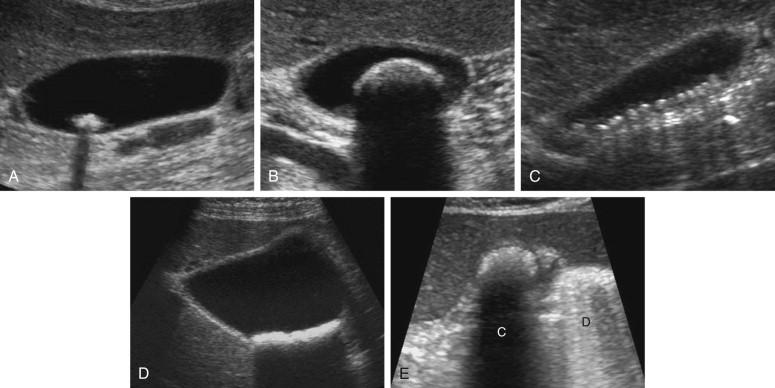
As described in Chapter 1 , technical factors need to be optimized to demonstrate shadowing. Because sound absorption increases at higher frequencies, nonshadowing stones may be converted into shadowing stones by switching to a higher transmit frequency ( Fig. 2-10A and B ). Another important factor is the focal zone. Because the beam profile is narrowest at the focal zone, it should be set at the depth of the stone so that the stone will absorb a greater percentage of the sound beam (see Fig. 2-10C and D ). Shadowing is better demonstrated using a single focal zone positioned at the appropriate level than multiple focal zones. Real-time compounding diminishes shadowing and should be deactivated when dealing with small poorly shadowing or nonshadowing stones. If there are multiple small stones, shadowing may best be demonstrated by positioning the patient so that the stones are clumped together.
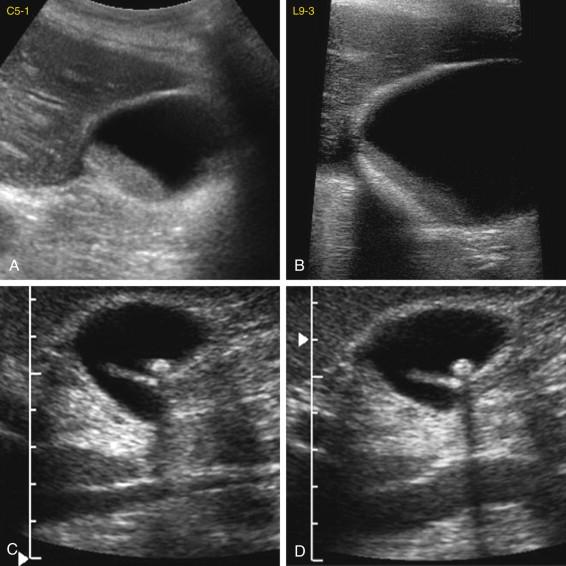
The major differential considerations for gallstones are gallbladder polyps and sludge balls ( Table 2-2 ). Polyps are small soft-tissue structures that are adherent to the gallbladder wall. They do not move or produce a shadow. Sludge balls (tumefactive sludge) are almost always mobile but do not produce a shadow. In addition, sludge balls are usually quite a bit larger than nonshadowing stones.
| Ultrasound characteristics | Common | Uncommon |
|---|---|---|
| Shadowing and mobile | Stones | Nothing else |
| Nonshadowing and mobile | Sludge | Stones (<3 mm) |
| Nonshadowing and nonmobile | Polyps | Sludge |
A gallbladder completely filled with stones is harder to recognize than when it is filled with a combination of bile and stones. All that is apparent is an echogenic shadowing structure in the RUQ that could be confused with a gas-filled loop of bowel. If an identifiable gallbladder is seen elsewhere, then the problem is solved. If not, the character of the shadow is important. In most cases, stones produce a clean shadow and gas produces a dirty shadow ( Fig. 2-9E ; see also Chapter 1 , Fig. 1-26 ). However, exceptions to this rule occur occasionally ( Fig. 2-11 ) and are probably a result of differences in the surface characteristics of gallstones. Another sign that can assist in differentiating between a stone-filled gallbladder and gas-filled bowel is the wall–echo–shadow (WES) complex. This consists of three arc-shaped lines followed by a shadow ( Fig. 2-12 ). The first line is echogenic and usually represents pericholecystic fat, the interface between the gallbladder wall and the liver, and the outer surface of the gallbladder wall. The second line is hypoechoic and represents the muscular layer of the gallbladder wall. The third is echogenic and arises from the stones ( ![]() ). Although a WES complex is a reliable sign of a stone-filled gallbladder, it is not possible to demonstrate it in every case. Therefore it is a useful finding when seen but it is not useful when absent.
). Although a WES complex is a reliable sign of a stone-filled gallbladder, it is not possible to demonstrate it in every case. Therefore it is a useful finding when seen but it is not useful when absent.
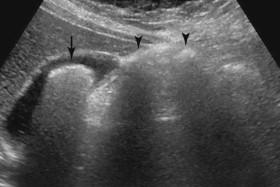

As mentioned earlier, the vast majority of gallstones fall to the dependent aspect of the gallbladder. When there are multiple small stones arranged in a layer along the dependent gallbladder wall, they might be confused with the wall itself. In such cases, identification of the stones and detection of an acoustic shadow are usually easier on transverse views ( Fig. 2-13 ).
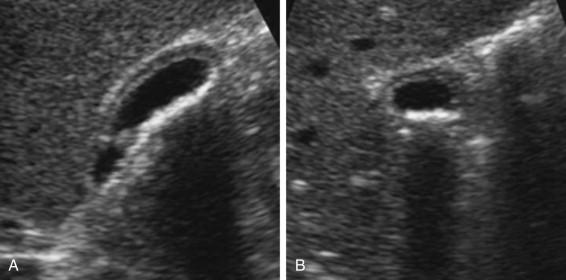
When the density of bile is unusually high, stones may float ( Fig. 2-14 ). This occurs when the specific gravity of bile is greater than the specific gravity of the stones and indicates that the floating stones are cholesterol in nature. This is one situation in which the composition of the stone can be predicted. One of the most common situations in which the specific gravity of bile increases is when intravenous contrast has been given and there is some degree of vicarious excretion in the gallbladder.

Gallstones are generally either round or ovoid. Faceted stones are also fairly common ( Fig. 2-15 ). Jack stones are a rare shape of stone that may or may not be predicted with sonography ( e-Fig. 2-2 ![]() ). Gallstones may also rarely develop gas-containing fissure. This is not visible on sonography, but can be seen on computed tomography (CT) and radiography ( e-Fig. 2-3
). Gallstones may also rarely develop gas-containing fissure. This is not visible on sonography, but can be seen on computed tomography (CT) and radiography ( e-Fig. 2-3 ![]() ).
).

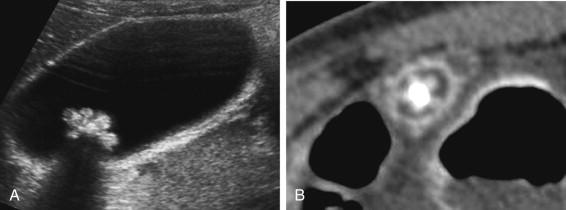
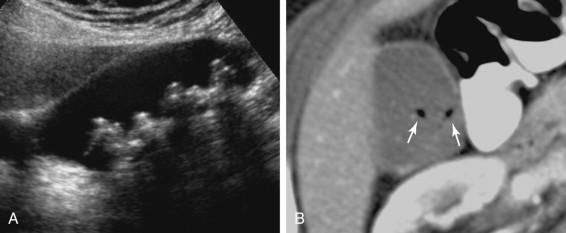
Sonography has assumed an important role in evaluating the gallbladder, because it is the most sensitive means of detecting gallstones. Multiple studies have documented sensitivities of greater than 95% and positive and negative predictive values that are close to 100%. Even in obese patients, sonography is the best way to detect stones.
Approximately 15% of gallstones are visible on abdominal radiographs. CT is significantly better in detecting gallstones than radiography, but is significantly less sensitive than sonography. This is because noncalcified cholesterol stones may have the same attenuation value as bile and be occult on CT ( Fig. 2-16 ). At best, CT has sensitivity of approximately 80%. Magnetic resonance imaging (MRI) is excellent at detecting gallstones, although probably not as sensitive as sonography. Endoscopic ultrasound is also excellent at detecting stones in the gallbladder, as well as in the common bile duct.
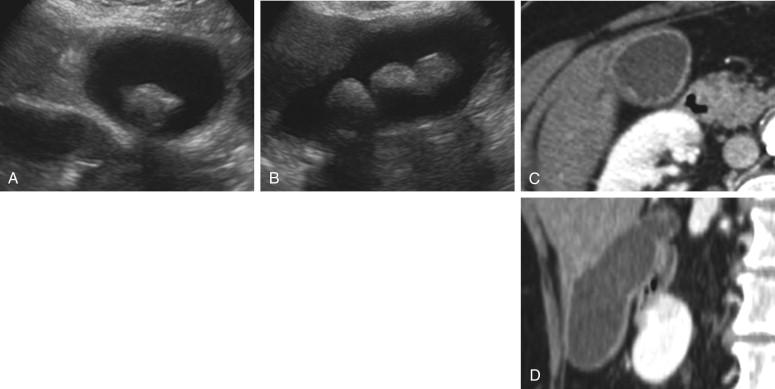
Become a Clinical Tree membership for Full access and enjoy Unlimited articles
If you are a member. Log in here